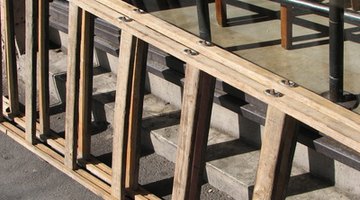How to Design a Ladder
An engineer can design a ladder to be much safer than some of the ladders in use, reducing the risk of injury while using a ladder, according to the Department of Mechanical Engineering at the University of Utah.

Things You Will Need
- Drafting paper
- Pencil
- Eraser
Each year, many accidents happen that could have been prevented by using the appropriate ladder for a job or safer ladder. There are a lot of factors to weigh when designing a ladder from material to support and safety features.
-
Pick the material to be used for the ladder. Ladders can be made from a variety of materials, including wood, fiberglass and aluminum. The material that you select will play a role in what type of design you will create. Different materials can bear weight differently, and can be taller or shorter than other materials.
-
Decide the job intended for the ladder. A fireman would not use a wooden ladder to fight fires, since the wood could catch fire. An electrician would not use an aluminum ladder to work on power lines, since the metal could conduct electricity and seriously harm him. Selecting the right ladder for the job is essential to designing a quality ladder. Know what you want to make before beginning the design process.
-
Learn the design requirements for ladders. The United States Department of Labor: Occupational Safety and Health Administration (OSHA) offers guidelines for ladders. There are measurements and requirements for the side rails, steps, rungs and cages or wells. The website also gives the requirements for wooden and metal ladders.
-
Draft a design using OSHA guidelines. Once you have chosen the material and the job for the ladder, begin drafting a design. Using the guidelines and meeting the requirements for safety set by OSHA can help ensure the success of the ladder design. If the minimum safety requirements are not met, the ladder will not qualify for commercial marketing or use.
-
Make changes to design. Check over the draft to look for any potential problems with the design. Make any necessary changes to the plans.
-
Repeat steps one through four if you decide to use a different material, or to make additional ladder designs. Repeat steps three through four until you have achieved the design that you want.
Tip
Use common sense when designing a ladder. Unless it is for decoration, intricate design patterns will likely not be practical for job-specific use. Apply slip-resistant tape or pads to an aluminum or metal ladder to reduce the likelihood of slips.
Warning
Do not use a metal ladder when working with electricity or electrical current.
References
Resources
Tips
- Use common sense when designing a ladder. Unless it is for decoration, intricate design patterns will likely not be practical for job-specific use.
- Apply slip-resistant tape or pads to an aluminum or metal ladder to reduce the likelihood of slips.
Warnings
- Do not use a metal ladder when working with electricity or electrical current.
Writer Bio
Annabeth Kaine began writing in 2010 with work appearing on various websites. She has successfully run two businesses, held chairmanship positions on two fund-raising committees and received excellence-in-service awards for both. Kaine is completing her Bachelor of Arts in psychology.
Photo Credits
- Wooden ladder image by Tasha from Fotolia.com
- Wooden ladder image by Tasha from Fotolia.com
More Articles



